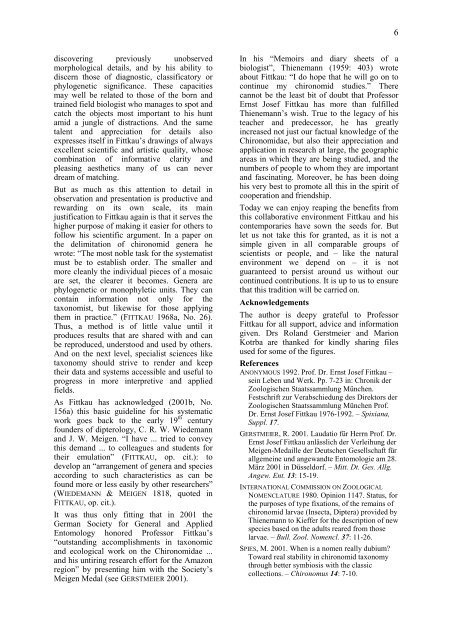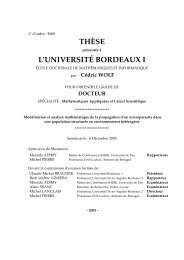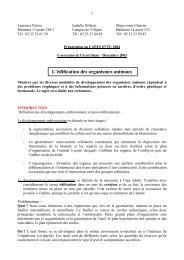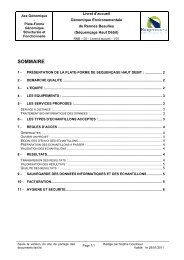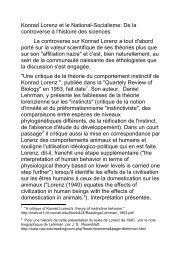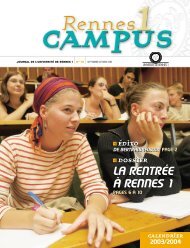1 CHIRONOMUS NEWSLETTER ON CHIRONOMIDAE RESEARCH ...
1 CHIRONOMUS NEWSLETTER ON CHIRONOMIDAE RESEARCH ...
1 CHIRONOMUS NEWSLETTER ON CHIRONOMIDAE RESEARCH ...
Create successful ePaper yourself
Turn your PDF publications into a flip-book with our unique Google optimized e-Paper software.
discovering previously unobserved<br />
morphological details, and by his ability to<br />
discern those of diagnostic, classificatory or<br />
phylogenetic significance. These capacities<br />
may well be related to those of the born and<br />
trained field biologist who manages to spot and<br />
catch the objects most important to his hunt<br />
amid a jungle of distractions. And the same<br />
talent and appreciation for details also<br />
expresses itself in Fittkau’s drawings of always<br />
excellent scientific and artistic quality, whose<br />
combination of informative clarity and<br />
pleasing aesthetics many of us can never<br />
dream of matching.<br />
But as much as this attention to detail in<br />
observation and presentation is productive and<br />
rewarding on its own scale, its main<br />
justification to Fittkau again is that it serves the<br />
higher purpose of making it easier for others to<br />
follow his scientific argument. In a paper on<br />
the delimitation of chironomid genera he<br />
wrote: “The most noble task for the systematist<br />
must be to establish order. The smaller and<br />
more cleanly the individual pieces of a mosaic<br />
are set, the clearer it becomes. Genera are<br />
phylogenetic or monophyletic units. They can<br />
contain information not only for the<br />
taxonomist, but likewise for those applying<br />
them in practice.” (FITTKAU 1968a, No. 26).<br />
Thus, a method is of little value until it<br />
produces results that are shared with and can<br />
be reproduced, understood and used by others.<br />
And on the next level, specialist sciences like<br />
taxonomy should strive to render and keep<br />
their data and systems accessible and useful to<br />
progress in more interpretive and applied<br />
fields.<br />
As Fittkau has acknowledged (2001b, No.<br />
156a) this basic guideline for his systematic<br />
work goes back to the early 19 th century<br />
founders of dipterology, C. R. W. Wiedemann<br />
and J. W. Meigen. “I have ... tried to convey<br />
this demand ... to colleagues and students for<br />
their emulation” (FITTKAU, op. cit.): to<br />
develop an “arrangement of genera and species<br />
according to such characteristics as can be<br />
found more or less easily by other researchers”<br />
(WIEDEMANN & MEIGEN 1818, quoted in<br />
FITTKAU, op. cit.).<br />
It was thus only fitting that in 2001 the<br />
German Society for General and Applied<br />
Entomology honored Professor Fittkau’s<br />
“outstanding accomplishments in taxonomic<br />
and ecological work on the Chironomidae ...<br />
and his untiring research effort for the Amazon<br />
region” by presenting him with the Society’s<br />
Meigen Medal (see GERSTMEIER 2001).<br />
In his “Memoirs and diary sheets of a<br />
biologist”, Thienemann (1959: 403) wrote<br />
about Fittkau: “I do hope that he will go on to<br />
continue my chironomid studies.” There<br />
cannot be the least bit of doubt that Professor<br />
Ernst Josef Fittkau has more than fulfilled<br />
Thienemann’s wish. True to the legacy of his<br />
teacher and predecessor, he has greatly<br />
increased not just our factual knowledge of the<br />
Chironomidae, but also their appreciation and<br />
application in research at large, the geographic<br />
areas in which they are being studied, and the<br />
numbers of people to whom they are important<br />
and fascinating. Moreover, he has been doing<br />
his very best to promote all this in the spirit of<br />
cooperation and friendship.<br />
Today we can enjoy reaping the benefits from<br />
this collaborative environment Fittkau and his<br />
contemporaries have sown the seeds for. But<br />
let us not take this for granted, as it is not a<br />
simple given in all comparable groups of<br />
scientists or people, and – like the natural<br />
environment we depend on – it is not<br />
guaranteed to persist around us without our<br />
continued contributions. It is up to us to ensure<br />
that this tradition will be carried on.<br />
Acknowledgements<br />
The author is deepy grateful to Professor<br />
Fittkau for all support, advice and information<br />
given. Drs Roland Gerstmeier and Marion<br />
Kotrba are thanked for kindly sharing files<br />
used for some of the figures.<br />
References<br />
AN<strong>ON</strong>YMOUS 1992. Prof. Dr. Ernst Josef Fittkau –<br />
sein Leben und Werk. Pp. 7-23 in: Chronik der<br />
Zoologischen Staatssammlung München.<br />
Festschrift zur Verabschiedung des Direktors der<br />
Zoologischen Staatssammlung München Prof.<br />
Dr. Ernst Josef Fittkau 1976-1992. – Spixiana,<br />
Suppl. 17.<br />
GERSTMEIER, R. 2001. Laudatio für Herrn Prof. Dr.<br />
Ernst Josef Fittkau anlässlich der Verleihung der<br />
Meigen-Medaille der Deutschen Gesellschaft für<br />
allgemeine und angewandte Entomologie am 28.<br />
März 2001 in Düsseldorf. – Mitt. Dt. Ges. Allg.<br />
Angew. Ent. 13: 15-19.<br />
INTERNATI<strong>ON</strong>AL COMMISSI<strong>ON</strong> <strong>ON</strong> ZOOLOGICAL<br />
NOMENCLATURE 1980. Opinion 1147. Status, for<br />
the purposes of type fixations, of the remains of<br />
chironomid larvae (Insecta, Diptera) provided by<br />
Thienemann to Kieffer for the description of new<br />
species based on the adults reared from those<br />
larvae. – Bull. Zool. Nomencl. 37: 11-26.<br />
SPIES, M. 2001. When is a nomen really dubium?<br />
Toward real stability in chironomid taxonomy<br />
through better symbiosis with the classic<br />
collections. – Chironomus 14: 7-10.<br />
6


